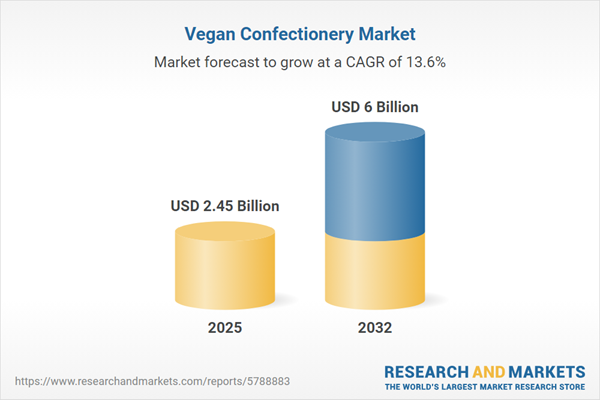Speak directly to the analyst to clarify any post sales queries you may have.
The vegan confectionery market is undergoing significant transformation as companies respond to rising sustainability pressures and complex regulatory mandates. For senior decision-makers, aligning agile procurement and risk-resilient sourcing is now critical to ensure stable growth and competitive positioning in this evolving sector.
Market Snapshot: Vegan Confectionery Market
The global vegan confectionery market continues to expand steadily, with a strong trajectory driven by surging demand for plant-based sweets. The market value is increasing from USD 2.16 billion in 2024 and is projected to reach USD 2.45 billion in 2025, ultimately achieving USD 6 billion by 2032. This solid compound annual growth rate highlights widespread adoption of plant-based alternatives as regulatory frameworks and corporate sustainability targets influence purchasing and supplier development strategies. Both established companies and new entrants are dedicating resources to product innovation, supply chain enhancements, and adaptive sourcing approaches to remain distinct in the marketplace. Organizations are re-examining operational models to respond to the evolving needs of global procurement and shifting market expectations.
Scope & Segmentation
This report equips procurement, supply chain, and sustainability leaders with actionable analysis designed to advance strategic planning and risk management within the vegan confectionery market. The comprehensive segmentation supports informed decisions across the entire value chain:
- Product Types: Includes plant-based bakery and confectionery offerings, such as cakes, muffins, croissants, donuts, cookies, chocolate bars, pralines, nougat, fruit and nut coatings, gummies, and hard candies.
- Distribution Channels: Assesses key B2B and retail channels—convenience stores, specialty retailers, supermarkets, hypermarkets, and digital procurement platforms—while highlighting the impact of digitalization on logistics efficiency and sourcing decisions.
- Price Tiers: Reviews the full pricing landscape, ranging from entry-level items for cost-sensitive buyers to premium options that aid in margin management and enable differentiated procurement strategies.
- Ingredient Certifications: Analyzes certification needs such as fair trade, non-GMO, and organic, offering guidance for due diligence and supplier audits to maintain compliance with global standards.
- Regional Coverage: Delivers specialized insights for the US, Germany, China, Brazil, the Americas, Europe, Middle East & Africa, and Asia-Pacific. Emphasizes local consumer trends, regulatory adaptation, and tailored market entry considerations.
- Company Profiles: Features strategic analysis on key industry players like Plamil Foods Ltd., Moo Free Chocolate Ltd., Veganz Group AG, Loving Earth Pty Ltd., and Sjaak’s Organic Confections, supporting supplier evaluation and partnership alignment.
Key Takeaways for Senior Decision-Makers
- Innovations in plant-based product development enable organizations to serve emerging customer preferences and deepen market reach while bolstering loyalty.
- Increased application of traceability tools, including blockchain, strengthens supply chain transparency and substantiates sustainability commitments for stakeholder confidence.
- Artificial intelligence integration in inventory and product management enhances forecast accuracy and allows more agile resource allocation.
- Expanding sourcing networks and prioritizing comprehensive supplier assessments reduce risks linked to cost fluctuations and supply interruptions.
- Regional strategy adaptation is key—North America focuses on product utility, Europe and the Middle East prioritize ethical supply, and Asia-Pacific responds rapidly to new sector innovations.
Tariff Impact: Navigating Supply Chain and Margin Shifts
With US tariffs set to take effect in 2025, ingredient costs for cacao and specialty sweeteners are anticipated to increase. Companies are countering these challenges by broadening supplier bases, diversifying origin sourcing, and implementing digital inventory systems, ultimately promoting secure supply continuity and profitability despite external cost pressures.
Methodology & Data Sources
This report’s insights are underpinned by executive interviews, supplier consultations, academic literature, and regulatory documents. Open-access data validation ensures findings are current and directly applicable for procurement and supply chain leaders in the vegan confectionery segment.
Why This Report Matters
- Supports anticipation of regulatory changes and seamless operational compliance, enhancing resilience and supply assurance for senior teams.
- Enables precise procurement benchmarking and the deployment of industry best practices, empowering informed decision-making and robust strategy development.
- Facilitates better investment and risk management with a detailed understanding of the industry drivers and disruptive factors impacting the vegan confectionery market across key regions.
Conclusion
Proactively integrating digital solutions and agile sourcing models empowers organizations to respond to shifting market forces. Informed, forward-looking strategies are integral to achieving sustainable growth and long-term market leadership in the vegan confectionery sector.
Additional Product Information:
- Purchase of this report includes 1 year online access with quarterly updates.
- This report can be updated on request. Please contact our Customer Experience team using the Ask a Question widget on our website.
Table of Contents
3. Executive Summary
4. Market Overview
7. Cumulative Impact of Artificial Intelligence 2025
Companies Mentioned
The companies profiled in this Vegan Confectionery market report include:- Plamil Foods Ltd.
- Moo Free Chocolate Ltd.
- Veganz Group AG
- Loving Earth Pty Ltd.
- Lovechock B.V.
- iChoc GmbH
- Vego Food GmbH
- Sjaak’s Organic Confections, Inc.
- Terra Vegane GmbH
- Seed and Bean Ltd.
Table Information
| Report Attribute | Details |
|---|---|
| No. of Pages | 187 |
| Published | October 2025 |
| Forecast Period | 2025 - 2032 |
| Estimated Market Value ( USD | $ 2.45 Billion |
| Forecasted Market Value ( USD | $ 6 Billion |
| Compound Annual Growth Rate | 13.6% |
| Regions Covered | Global |
| No. of Companies Mentioned | 11 |









